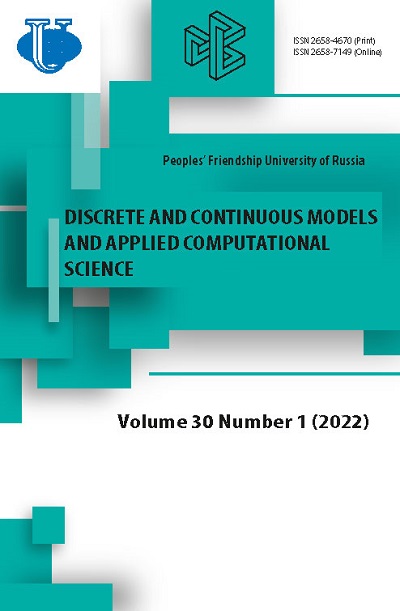The quantization of the classical two-dimensional Hamiltonian systems
- Authors: Belyaeva I.N.1
-
Affiliations:
- Belgorod State National Research University
- Issue: Vol 30, No 1 (2022)
- Pages: 39-51
- Section: Articles
- URL: https://journals.rudn.ru/miph/article/view/30325
- DOI: https://doi.org/10.22363/2658-4670-2022-30-1-39-51
- ID: 30325
Cite item
Full Text
Abstract
The paper considers the class of Hamiltonian systems with two degrees of freedom. Based on the classical normal form, according to the rules of Born-Jordan and Weyl-MacCoy, its quantum analogs are constructed for which the eigenvalue problem is solved and approximate formulas for the energy spectrum are found. For particular values of the parameters of quantum normal forms using these formulas, numerical calculations of the lower energy levels were performed, and the obtained results were compared with the known data of other authors. It was found that the best and good agreement with the known results is obtained using the Weyl-MacCoy quantization rule. The procedure for normalizing the classical Hamilton function is an extremely time-consuming task, since it involves hundreds and even thousands of polynomials for the necessary transformations. Therefore, in the work, normalization is performed using the REDUCE computer algebra system. It is shown that the use of the Weyl-MacCoy and Born-Jordan correspondence rules leads to almost the same values for the energy spectrum, while their proximity increases for large quantities of quantum numbers, that is, for highly excited states. The canonical transformation is used in the work, the quantum analog of which allows us to construct eigenfunctions for the quantum normal form and thus obtain analytical formulas for the energy spectra of different Hamiltonian systems. So, it is shown that quantization of classical Hamiltonian systems, including those admitting the classical mode of motion, using the method of normal forms gives a very accurate prediction of energy levels.
Full Text
Introduction Representation of the original classical Hamilton function in normal form as the sum of homogeneous polynomials in canonically conjugate coordinates and momenta [1] allows us to carry out its quantum-mechanical description. The main provisions of the new quantum mechanics were discovered by W. Heisenberg in 1925 [2]. In the same year, the paper was published by © Belyaeva I.N., 2022 This work is licensed under a Creative Commons Attribution 4.0 International License http://creativecommons.org/licenses/by/4.0/ M. Born and P. Jordan [3], in which the commutation relation for the quantummechanical operators of coordinate
About the authors
Irina N. Belyaeva
Belgorod State National Research University
Author for correspondence.
Email: ibelyaeva@bsu.edu.ru
Candidate of Physical and Mathematical Sciences, Associate Professor
85, Pobedy St., Belgorod, 308015, Russian FederationReferences
- N. N. Chekanova, I. K. Kirichenko, V. E. Bogachev, and N. A. Chekanov, “The classical and quantum approach in the study of a nonlinear Hamiltonian system,” Bulletin of the Tambov State University. Series “Natural and Technical Sciences”, vol. 20, no. 1, pp. 120-137, 2015.
- W. Heisenberg, “Über quanten theoretisсhe Umdeutung kinematisсher und mechanischer Beziehungen,” Zeitschrift für Physik, vol. 33, pp. 879-893, 1925. doi: 10.1007/BF01328377.
- M. Born and P. Jordan, “Zur quanten mechanik,” Zeitschrift für Physik, vol. 34, pp. 858-888, 1925. doi: 10.1007/BF01328531.
- P. Digas, “Fundamental Equations of Quantum Mechanics,” Proc. Roy Soc. (Lnd.)., pp. 642-653, 1925. doi: 10.3367/UFNr.0122.197708e.0611.
- H. Weyl, “Quanten Mechanik und Gruppen Theorie,” Zeitschrift für Physik, vol. 46, pp. 1-46, 1927. doi: 10.1063/1.1664478.
- G. Weil, The theory of groups and quantum mechanics. Martino Fine Books, 2014.
- N. H. McCoy, “On the function in quantum mechanics which corresponds to a given function in classical mechanics,” Proceedings of the National Academy of Sciences (PNAS), vol. 18, pp. 674-676, 1932. doi: 10.1073/pnas.18.11.674.
- S. R. De Groot and L. G. Suttorp, Foundations of Electrodynamics. Amsterdam: North-Holland publishing company, 1972. doi: 10.12691/amp-2-3-6.
- A. N. Argyers, “The Bohr-Sommerfeld quantization rule and the Weyl correspondence,” Physics, vol. 2, p. 131, 1965. doi: 10.1103/PhysicsPhysiqueFizika.2.131.
- L. Castellani, “Quantization rules and Dirac’s correspondence,” Il Nuovo Cimento A, vol. 48, pp. 359-368, 1978. doi: 10.1007/BF02781602.
- P. Crehan, “The parametrisation of quantization rules equivalent to operator orderings and the effect of different rules on the physical spectrum,” Journal of Physics A: Mathematical and General, vol. 22, no. 7, pp. 811-822, 1989. doi: 10.1088/0305-4470/22/7/013.
- P. Crehan, “The proper quantum analogue of the Birkhoff-Gustavson method of normal forms,” Journal of Physics A: Mathematical and General, vol. 23, no. 24, pp. 5815-5828, 1990. doi: 10.1088/03054470/23/24/022.
- W. A. Fedak and J. J. Prentis, “The 1925 Born and Jordan paper “On quantum mechanics”,” American Journal of Physics, vol. 77, pp. 128- 139, 2009. doi: 10.1119/1.3009634.
- M. A. Gosson, “Born-Jordan quantization and the uncertainty principle,” Journal of Physics A: Mathematical and Theoretical, vol. 46, pp. 445-462, 2013. doi: 10.1088/1751-8113/46/44/445301.
- M. Razavy, Heisenberg’s quantum mechanics. Singapore: World Scientific Publishing Co. Pte. Ltd., 2011. doi: 10.1080/00107514.2011.603435.
- N. A. Chekanov, “Quantization of the normal form of Birkhoff- Gustavson [Kvantovaniye normal’noy formy Birkgofa-Gustavsona],” Nuclear Physics, vol. 50, no. 8, pp. 344-346, 1989, in Russian.
- H. Taseli, “On the Exact Solution of the Schroedinger Equation with a Quartic Anharmonicity,” International Journal of Quantum Chemistry, vol. 57, no. 1, pp. 63-71, 1996. doi: 10.1002/(SICI)1097-461X(1996) 57:1<63::AID-QUA7>3.0.CO;2-X.
Supplementary files















